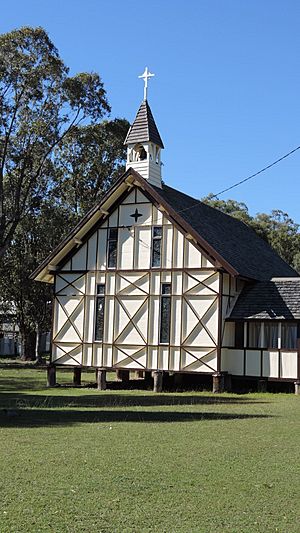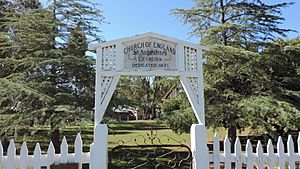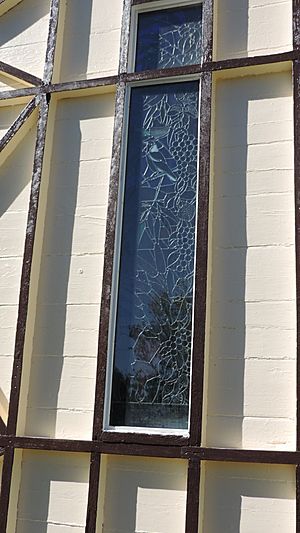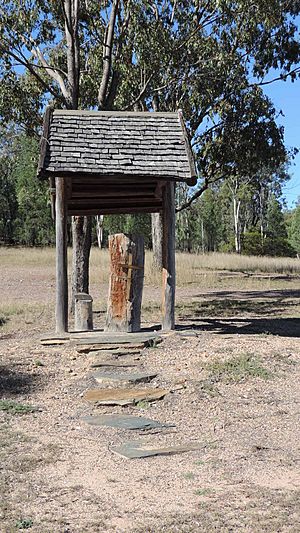St Augustine's Anglican Church, Leyburn facts for kids
Quick facts for kids St Augustines Anglican Church, Leyburn |
|
|---|---|

St Augustines Anglican Church, Leyburn, 2015
|
|
| Location | Dove Street, Leyburn, Southern Downs Region, Queensland, Australia |
| Design period | 1840s - 1860s (mid-19th century) |
| Built | 1871 - 1918 |
| Architect | Richard George Suter |
| Architectural style(s) | Gothic |
| Official name: St Augustines Anglican Church, Leyburn, St Augustine's Church of England, Leyburn | |
| Type | state heritage (landscape, built) |
| Designated | 21 August 1992 |
| Reference no. | 600828 |
| Significant period | 1870s (historical) 1870s, 1910s (fabric) |
| Significant components | furniture/fittings, fencing, lamp/s - gas, stained glass window/s, vestry, churchyard, gate/s, views to, church |
| Builders | John Baillie |
| Lua error in Module:Location_map at line 420: attempt to index field 'wikibase' (a nil value). | |
St Augustines Anglican Church is a very old and special church in Leyburn, Queensland, Australia. It's known for its beautiful design by Richard George Suter. The church was built a long time ago, between 1871 and 1918. It's also called St Augustine's Church of England. Because it's so important, it was added to the Queensland Heritage Register on August 21, 1992.
Contents
A Look Back: Leyburn's Early Days
Leyburn started as a small settlement near Canal Creek in the 1840s. It grew to help settlers who followed a stock route made by the Leslie brothers in 1840. By 1853, it was known as Leyburn. The first land sales happened in 1857.
By 1872, Leyburn had a school, a church, a police station, and a courthouse. It also had shops, a sawmill, and three hotels. The town was often dusty from teams of horses and flocks of sheep passing through. Many men worked as carriers on the road to Goondiwindi or on nearby farms. They would return to their families in Leyburn on weekends.
Leyburn: An Important Hub
Leyburn was a key spot for drovers, travelers, and government services. From 1852, it became a mail center for the area. In 1872, it got connected to the electric telegraph system. This made it an important station for messages between Sydney and Brisbane.
Leyburn also had courts for small legal cases starting in 1861. A police magistrate was appointed, and a lock-up (small jail) was built. A courthouse followed in 1867. The Leyburn National School opened in 1862, showing the town's growth.
How Leyburn Changed
Leyburn's importance began to fade when the railways were built. In 1868, a train line connected Toowoomba to Dalby. In 1871, another line linked Toowoomba to Warwick. This meant less traffic passed through Leyburn.
Later, in the 1900s, the South Western railway line was built from Warwick to Goondiwindi. This new line completely bypassed Leyburn. This further reduced the number of people and goods passing through the town.
Building St Augustine's Church
Anglican church services had been held in Leyburn since the 1840s. Early services took place in public houses and later in the courthouse. In 1861, the Anglican parish of Leyburn was officially formed. A house for the priest was built on land given by the Gore family. However, a church building wasn't built until 1871.
A Gift from England
The building of the church was largely thanks to the Bishop of Brisbane, Edward Wyndham Tufnell. He decided that Leyburn would receive money sent by students from the College of St Augustine in England. This money was meant to build a church in Queensland.
The church site was chosen on the main Warwick Road, near the courthouse. It was bought in 1870 for £4. Soon after, tenders (offers) were accepted to fence the church ground. Architect RG Suter called for tenders to build the new church in September.
The Church's Construction
The church was built using 12-inch pit-sawn timber, and its roof was made of wooden shingles. The builder was John Baillie. The church, named after St Augustine of Canterbury, was officially opened in September 1871 by Bishop Tufnell.
The Architect: Richard George Suter
Richard George Suter (1827–1894) was a very important architect. He designed at least ten churches during Bishop Tufnell's time (1859–1874). These included St Mark's Warwick (1867–70) and St James' Toowoomba (1868–69). He also designed timber churches like St Andrew's Lutwyche (1866).
Suter also did a lot of work for the Queensland Board of Education. His early schools, like his churches, used timber with outside studding. This was a clever way of building that Suter made popular in Queensland. He designed only a few houses, but homes like East Talgai (1868) and Jimbour (1873–74) are some of the most impressive in Queensland.
Changes Over Time
After the railways caused Leyburn to decline, the church parish changed its main center to Pittsworth in 1889. To help the priest, who now traveled from Pittsworth, a vestry (a room for changing robes) was added to the church in 1918.
The original wooden shingles on the roof were replaced between 1889 and 1924. In 1931, the roof was re-shingled again. More recently, in 1993, the roof was re-shingled using ironbark wood from a local family's property.
In 1986, beautiful stained glass windows were put in behind the altar. A memorial was also placed in the church grounds by the local historical society. It honors gold miner Dan Bray and all the early gold miners of Leyburn.
On November 14, 2021, St Augustine's Anglican Church celebrated its 150th birthday!
What the Church Looks Like
St Augustine's Church is in Leyburn, a small village about 50 kilometers northwest of Warwick. The church is made of timber with its wooden frame showing on the outside. It has a steep roof covered in hardwood shingles. It looks like old English village churches and has many Gothic features.
Church Layout and Features
The church sits in the middle of its property, which gently slopes to the east. The main part of the church, called the nave, faces east-west. The chancel (the area around the altar) is at the eastern end. You enter the church grounds through a timber archway with a small pine tree and picket fence on each side.
The church is a simple rectangular shape. The chancel is at the east end, and a porch is on the south side of the west end. A small addition for the vestry is in the south-east corner. The wooden frame of the walls is visible on the outside, making a decorative pattern. The inside walls are made of wide cypress pine planks laid flat.
The roof is very steep with pointed ends and a small bell-cote (bell tower) at the western end. The roof is covered with hand-split hardwood shingles. The main entrance door has a pointed arch shape and still has its original lock.
Inside the Church
Inside, the nave has a special light. This light comes from a continuous opening between the top of the walls and the roof frame. The tall, narrow windows also let in a unique light. These windows have a three-leaf shape on the outside, which creates a Gothic-like shadow inside. They open by sliding along tracks.
The floor is made of wide, raw cypress pine boards. They are kept clean to look bleached. The exposed roof frame and trusses (support beams) have been stained. The arch leading to the chancel is also pointed and lined with beaded wood.
The church furniture, like the altar, lectern (reading stand), pulpit (preaching stand), and pews (benches), are believed to be from when the church was first built. They are made of stained pine. The stone baptism font can be moved. The altar has been moved closer to the congregation. The original wooden screen from the altar is now stored in the vestry. Behind the altar, there are now beautiful stained glass windows. Gas lamps on swiveling brackets are on the side walls of the chancel.
The newer vestry room is lined with narrow boards. It holds a dresser, washstand, bed, and wardrobe. The church's bellows organ is also stored here. You can also find the original gas lamps from the roof and the dedication chalice and plate in this room.
Why St Augustine's is Special
St Augustines Anglican Church in Leyburn was added to the Queensland Heritage Register on August 21, 1992. This means it's a very important historical site.
A Unique Design
St Augustine's was designed by RG Suter, one of Queensland's most famous architects. He designed many important homes and schools. His timber buildings, like St Augustine's, were special because they were affordable, looked good inside, and had a charming appearance. St Augustine's is believed to be his only remaining timber church. At the time, some people thought timber wasn't suitable for churches, but Suter proved them wrong with his beautiful designs.
A Link to the Past
St Augustine's, along with other old buildings from the 1860s and 1870s, shows how Leyburn used to be a busy and important town. It's a great example of an early Queensland town that has kept its original look. It also helps us understand the history of settlement in the Darling Downs area.
Rare and Beautiful
St Augustine's is a rare example of a building with a surviving timber shingled roof. It's even more special because the playshed at Leyburn State School also has a shingled roof. The church's timber work and simple Gothic style give it a delicate and charming look. The way light comes into the church through the eaves and windows creates a truly special feeling inside.
Important to the Community
St Augustine's is a symbol of Leyburn's past and an important part of its town. It helps tell the story of the Darling Downs settlement. The church has a strong connection with the local community for its social, cultural, and spiritual meaning.
Connected to a Famous Architect
The church has a special link to the life and work of RG Suter, a very important architect in Queensland's history.





